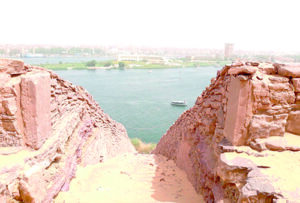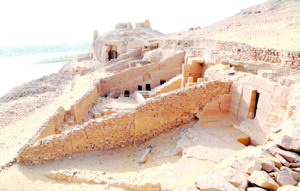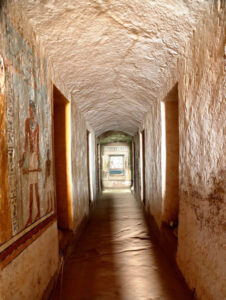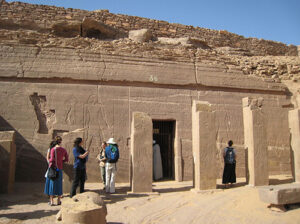Qubbet el-Hawa (Arabic for Dome of the Wind) is one of the most attractive sites in Aswan in southern Egypt, even as few people know about it.
Located on the West Bank of the Nile, it is a rocky mountain that is 130 metres high.
The mountain is famous for the many tombs of priests, nobles and governors of Aswan through different eras it houses.
Princes, nobles and governors belonging to the Old Kingdom (sixth dynasty) and the Middle Kingdom (of the XII dynasty) are buried in the mountain.

Tombs belonging to the modern state and the late era were also discovered in the same area, adding to its historical value.
The area derives its name from the tomb of Sidi Ali Abu el-Hawa, which is located on the southern peak of the mountain.
This tomb is both different and distinctive. It has a white dome. It can be seen from afar. This is why visitors of the area identify it on a distance when they see the white dome.
The Sidi Ali Abu el-Hawa is unique in that it was built on the ruins of a Coptic monastery.
The tombs of the area acquire their fame from their beauty. Most of the tombs of the Dome of the Wind area have decorated walls that inscriptions on them.
These inscriptions tell the story of people who lived in Aswan a very long time ago. They also describe their day-to-day life in great detail.

The mountain area contains about 85 cemeteries. Ten more cemeteries were discovered recently.
It consists of chambers carved into the mountain. These chambers differ from each other in size, shape and design.
The walls of the tombs are decorated with a wide range of drawings. Some of the drawings show men slaughtering cows, others fishing, and a third group of others playing music.
Some of the tombs also contain moulds that were used by people in old times in casting copper and gold for the manufacture of statues.
The Dome of the Wind was first mentioned by a German traveller in a book he wrote about southern Egypt in 1819.
The tombs of the area were then discovered by a British researcher in 1886. The tombs’ discovery focused interested in them in the subsequent years.

The area was excavated for seven years as of 1946 by Egyptian archaeologist Labib Habashi.
One of the international expeditions sent to the area was sent by the University of Bonn.
Each of the tombs of the mountain acquires its importance from the fame of the person(s) buried in it, as well as from the stories inscribed on its walls.
The most important tombs of the area include that of Mekhu. The tomb is 150 square metres wide and contains a main room and another room for worship.
The tomb has a main false door on the back side of the worship room. There is a granite offering table in the main compartment. This compartment also has four other fake doors.
Mekhu led a large number of campaigns in Nubia. He was killed in the desert while he was on an expedition to Nubia.

His tomb is only one of many important ones located in the same mountain area.
Aswan can be reached from Cairo by air or by train. The southern city contains a long list of important sites that are worth of visiting.
It also has a large number of hotels that suit all budgets.







Discussion about this post